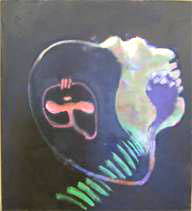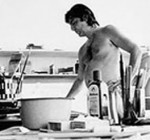
John Altoon
American, 1925-1969
Untitled (Sunset Series) , 1964-1965
oil on canvas
60 x 56 1/4 in.
SBMA, Museum purchase, Ludington Deaccessioning Fund
2010.9

Undated photograph of John Altoon in his LA studio.
The introduction for a retrospective show at California Institute of Technology in 1980 states, "John Altoon was one of the best artists who ever worked in Southern California, turning an exceptional talent for draftsmanship and a strong need for the expression of deeply personal feelings into a unique - sensual and humorous as well as violent approach to Abstract Expressionism, and on paper, to figurative art.The irony about his career is that he was going against the artistic direction of the time, both in NY and in Europe, and often even that taken by his peers in Southern California.There was an exceptional honesty and vitality in him that came out strongly in his art, and it is greatly to his credit that he went his own way."
COMMENTS
John Altoon was born in Los Angeles in 1925, the son of Armenian immigrants. In 1947 at the age of 22, after serving in the Pacific during World War 11, he returned to Los Angeles. He attended Otis Art Institute and Chouinard Art Institute with the help of the GI Bill, and studied commercial art. After some commercial success, but wanting to be a "true artist," he moved to Santa Barbara in 1951 where he had a one-man exhibition at SBMA. Soon afterward he moved to NY, living as an artist for four difficult years trying to work out his own identity in both fine art and commercial illustration. John Altoon was a superb draftsman and throughout his career he used commercial work to fund his fine art work. John Altoon created both figurative and abstract works throughout his life and showed a growing interest is Abstract Expressionism through the 1950s.
While in NY and during the following year in Europe, he continued creating art but was also experiencing periods of severe depression and extreme psychosis. These illnesses prompted his return to his parent's home in LA in 1956. In Los Angeles he befriended Edward Kienholz and Walter Hoppe, founders of the Ferus Gallery, an important center for LA art. There his work was included in an exhibition in 1957, a show that introduced Abstract Expressionism to Southern California. He became an important member of the Ferus Gallery Group through 1963. Described by gallery owner Irving Blum, he was "dearly loved, defiant, romantic, highly ambitious and slightly mad ... incredibly gifted and absolutely brilliant".
Altoon's imagery is uniquely his own. His work in drawing and painting during the last nine years of his life show a fascination with and ambivalence toward women, satire, humor and violence. In 1962 he began to satirize advertising layouts in a series of 5 foot x 40-inch drawings. He created "Satires" which were groups of highly erotic and sexualized drawings that are both funny and insightful, and disturbing.
In 1963 after a period of extreme emotional distress, hospitalization and shock therapy, John Altoon found a psychotherapist who had a profoundly positive effect on his life and art. He began teaching at Chouinard in LA. During this time he created his "Ocean Park Series," a breakthrough group of paintings in which he began using biomorphic forms, which are abstract images that refer to, or evoke living forms. Using brightly colored biomorphic shapes and forms clustered, yet floating over empty white-primed canvases he found his own artists voice. Sometimes the objects in his drawings and paintings can be read literally but more often the biomorphic forms are his very personal symbolism accessed through free association.
In 1964 he had begun using an airbrush, appropriated from his commercial work, which allowed him to define areas with a fine mist of color that result in a soft fantastic quality. He made hundreds of drawings with the airbrush from 1964-67. Also in 1964 he began transferring to his paintings on canvas the look he had achieved in his drawings on illustration board. He simplified his compositions by selecting one or two biomorphic shapes and centrally isolating them against a deeply colored ground.
In the mid 1960's he was continuing his psychotherapy and feeling some relief from his mental illness. By 1965 he had reached a maturation of style. Paintings from the "Hyperion" and "Sunset Series", with their beautifully executed and luscious areas of color and brushwork, are the culmination of years of Altoon's search for his own form of expression. It has been said that John Altoon displays the surrealists power to transform the world of the subconscious into art, but he does it in a way and with an insight which is uniquely his own.
In later works such as ours, Altoon was still exploring the possibility of biomorphic forms as vehicles for very personal expression, but it had become a darker if more tranquil vision. Our oil painting, "Untitled, (Sunset Series)" done in late 1964 or '65, is ominous and yet somewhat light in feeling at the same time. The slate and varying brown to deep gray background surrounds the repeated light green lines and the lively pink form. These forms, are distinct, three dimensional, and appear almost to be lit from the outside. In some areas there is a spare application of paint, and the texture of the canvas can be seen. In our painting one can see the airbrush spray, as well as visible brush strokes. The airbrush shows a subtlety of the surface and merging of background into foreground through the softness of the sprayed edges. It creates shading in some of the shapes. His technique sets up a sense of space so that rather than looking at a flat surface on which the artist has recorded his experience, the viewer looks into a three dimensional space he has created.
In 1968 he began a very different approach to painting. He experimented with different shaping of the canvases and began to explore a classical formalism combined with his own expressionism. In 1969 John Altoon died suddenly at the age 43 after suffering a massive heart attack.
